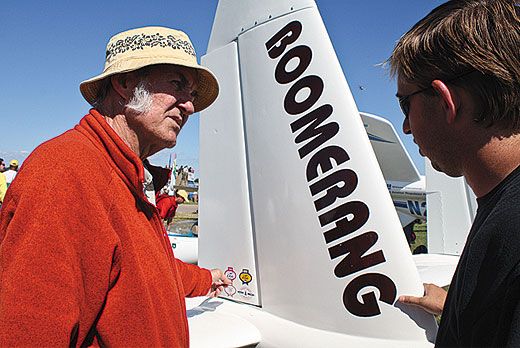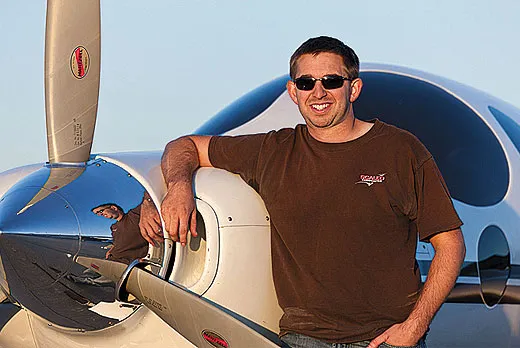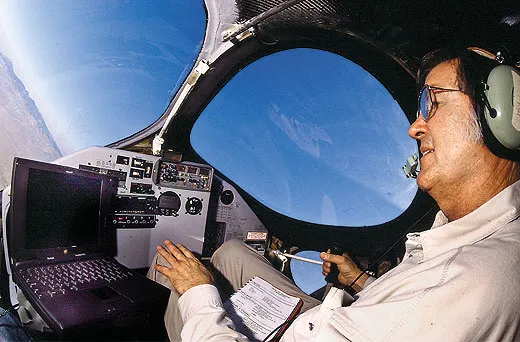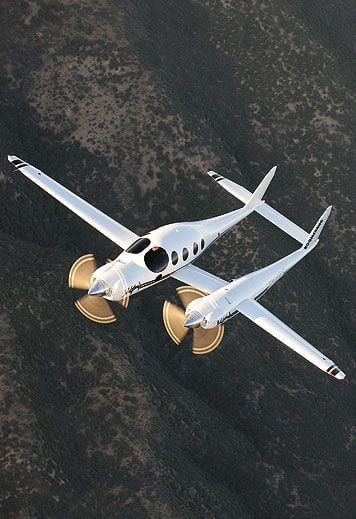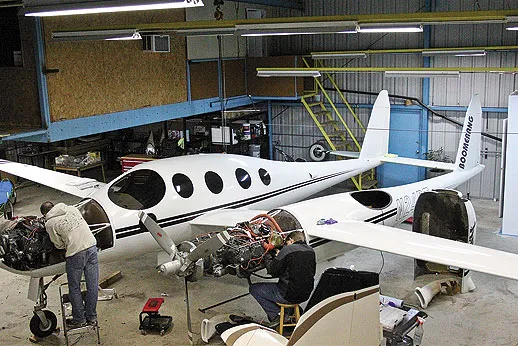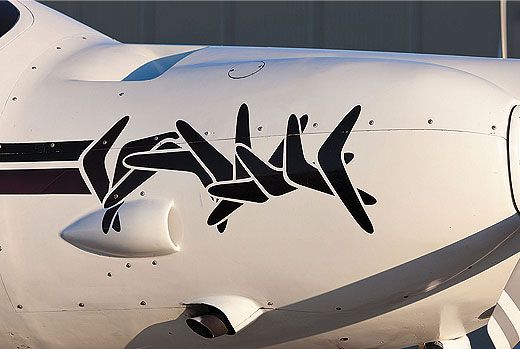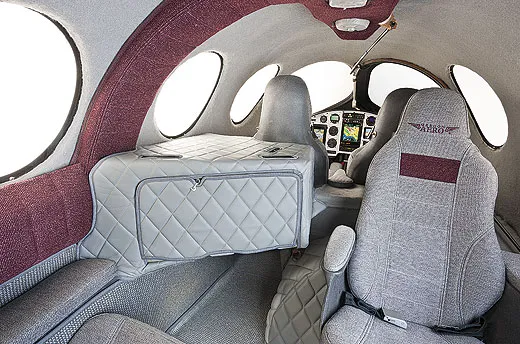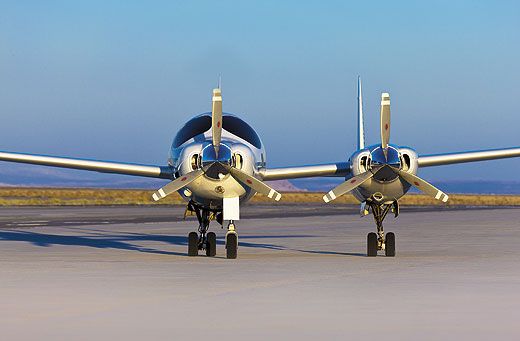Burt Rutan’s Favorite Ride
The Boomerang could be the safest twin ever built
/https://tf-cmsv2-smithsonianmag-media.s3.amazonaws.com/filer/Burt-Rutans-Favorite-9-1-2012-5_FLASH.jpg)
When I first saw the Boomerang, Burt Rutan’s twin-engine, asymmetric, five-place, long-range oddity, my reaction, like that of a number of Rutan fans who witnessed the airplane’s debut at the 1996 Oshkosh, Wisconsin AirVenture, was Why? Why is there a small boom to the left of the fuselage? Why is the second engine, in the nose of the boom, five feet behind the engine on the fuselage nose? Why is the right wing almost five feet shorter than the left? Why are the wings swept forward? Why does the horizontal stabilizer, which joins the fins on the twin tails, extend past the right fin, but not past the left?
In March, when Rutan received the National Air and Space Museum trophy for lifetime achievement, he gave an interviewer a short answer to those questions: “Self preservation.” The longer answer concerns how a conventional twin behaves when one of the engines quits. Last fall, with the help of Boomerang custodian Tres Clements and California flight instructor Chuck Coleman, I compared the engine-out performance of the Boomerang with that of a conventional twin.
Coleman and I flew his Beechcraft Baron around his home airport in Mojave. The Baron is one of the best selling twins on the market, a pretty, lightweight, six-seat aircraft that cruises at about 200 mph. Like most twins, it has an engine on each wing. If one engine fails, the asymmetry of the thrust will forcefully turn the airplane in the direction of the inoperative engine, which is producing drag.
To maintain straight and level flight, the pilot must add rudder and aileron in a coordinated fashion in the direction of the good engine. For example, if the left engine is out, the pilot adds right rudder and banks to the right. To earn a multi-engine rating, every pilot must perform this maneuver to the satisfaction of a flight instructor.
While controlling the aircraft in this way, a pilot must keep the airspeed above the minimum controllable speed (Vmc). For every twin-engine aircraft, this speed, the minimum at which the airplane can be flown with one engine inoperative, is established during flight testing. “In most twins, the [minimum controllable speed] is above the stall speed,” says Coleman. “So if you were to lose one engine abruptly and you’re below that Vmc/stall speed, it’s going to flip over on its back instantly.” Pilots train to avoid that situation.
During our flight, Coleman brought the left engine to idle and feathered the propeller (angling the blades to create the least drag). Thinking of airspeed, the first thing I did was add full power to the right engine. To keep from turning, I rolled in plenty of right aileron and pushed the right rudder pedal. I had to push it all the way to the floor just to keep the airplane flying straight ahead. In seconds, holding the pressure needed on the rudder pedal was making my leg shake uncontrollably. The yoke was turned almost as far as it could go. All the while I was keeping my eye on the airspeed indicator to make sure we stayed above the 80-knot blue line, indicating the Vmc.
Even though I was able to maintain my altitude and heading, it took immense effort. With that demonstration, I understood how difficult and dangerous it is to fly a traditional twin with only one engine, and what Rutan was trying to achieve with the Boomerang.
“My goal was to have the minimum control speed well below the stall,” Rutan says. In the Boomerang, the wing stalls at its root, near the fuselage, long before the outboard wing. The pilot experiences all the indications of stall, including buffeting, even though part of the airplane is still producing lift. Rutan wanted an airplane that could be controlled even after the onset of stall.
“The first time I feathered [a Boomerang prop] and was slowing down with the other engine at full power, it wasn’t real obvious what I should do with the rudder pedals,” says Rutan. “It’s real obvious on a Baron—you better be putting rudder in and quite a bit.” So I had found part of the answer to my question Why? But I was curious about How? And even more curious to know What does it feel like to fly the Boomerang on one engine? I got the answer to that question because Burt Rutan decided to retire.
Safety First, Range Next
The Boomerang had its roots in two of Rutan’s earlier designs: the twin-engine Defiant and the high-performance, single-engine Catbird. In fact, he used the Catbird nose gear and engine on the Boomerang.
The Defiant has one engine in the front and another in back; such centerline-thrust designs enable an airplane to continue flying safely if either engine shuts down. Centerline thrust, however, has drawbacks. “When you have a pusher-propeller aft of the wing, it vibrates and creates noise,” Rutan says.
Rutan flew the Defiant as his personal aircraft for years, but he wanted an aircraft that had the range to go to Australia or Europe. He began thinking of a long-range twin at about the time the Catbird won the 1988 CAFE 400 race for efficiency, fuel economy, speed, and payload capacity. The Catbird still holds two speed records.
“I decided that I’m going to do a twin with the same type of attention to performance that I had put into the Catbird,” Rutan says. “My plan was to design the lowest-drag light twin that I could, and while I was at it have a lot of fuel, make a lot of range, and of course have the Defiant, or better, engine-out characteristics.”
At a presentation for the Society of Experimental Test Pilots, Rutan explained the Boomerang’s performance by walking his audience through a list of incremental changes to a traditional twin-engine design—a Beechcraft Baron, in fact. The series of changes transformed the conventional twin into an airplane that could fly symmetrically on two engines or one (see diagram, p. 42). In both the Catbird and the Boomerang, Rutan reduced drag by using a dolphin-shaped fuselage that narrows between the cabin and the tail. He modified airfoils used on his early craft, like the Voyager, to create an efficient, low-drag airfoil for the Boomerang’s wings.
Rutan knew he wanted a turbocharged airplane, like the Catbird, because it would enable him to fly at much higher altitudes, where, in thinner air presenting less resistance, the airplane could fly faster, or farther, using less fuel.
Built of lightweight composites, the Boomerang can carry five people, their luggage, and 171 gallons of fuel almost 1,900 miles (1,652 nautical). Running its two Lycoming engines (210 horsepower on the fuselage; 200 on the nacelle) at 75 percent power, a pilot can cruise that distance at 302 mph. Reducing the power settings to 37 percent will stretch the range to more than 2,960 miles cruising at 215 mph and 20,000 feet.
For six years, beginning in 1996, Rutan flew everywhere in the Boomerang. In 2002, a series of heart surgeries limited his flying. When he announced his retirement from his company, Scaled Composites, in late 2010, he planned to donate the airplane to a museum, but the more he thought about the idea, the less he liked it. Instead, he began looking for “someone who could enjoy its features and would work to restore it and keep it flying indefinitely.”
At the time, Tres Clements, a 28-year-old engineer who had been at Scaled Composites for a year and a half, was one of several volunteers working at night and on weekends on the last aircraft Rutan designed before he retired: a twin-boom, roadable aircraft known as the Bipod. (It’s not uncommon to find lights on in the Mojave Airport hangars late into the night as dozens of aircraft designers and builders work on their personal projects.) When Clements asked Rutan what he planned to do with the Boomerang, Rutan answered, “I don’t know. Do you want it?” At first, Clements thought he was joking, but that’s how he became the caretaker of the historic aircraft. Clements spent the next four months restoring the Boomerang, with the help of a team that included former Scaled test pilot Mike Melvill and engineer Ryan Malherbe. In July 2011, Clements, Malherbe, and Bob Morgan, the project engineer for mothership WhiteKnightTwo, flew the restored Boomerang to Oshkosh for a tribute to Rutan and his extraordinary airplanes.
Flying the Boomerang
“The first time I pulled an engine back, I was like, Wow, I can’t believe it actually flies like this,” Clements says. “It’s not doing what you’d expect. It’s flying really nicely when it should be flying really bad.” Last October, when Clements flew the airplane from Mojave to Oregon Aero, a company north of Portland that had offered to install a new interior, I hitched a ride.
Getting into the Boomerang’s cockpit isn’t easy. There isn’t a traditional door. Instead, there is a large oval window, which is on a rail and slides back to provide a wide space to climb through. The window is unlatched by a lever on the fuselage that folds down to double as a foothold.
The foothold is about at the waist of my 5-foot-10 frame, and for someone like me, with long legs and not great flexibility, it was a bit of a challenge to get my foot on the step. In the fuselage, you step on a shelf, taking care not to bump any knobs on the instrument panel.
In the Boomerang, the pilot-in-command sits in the right seat. This atypical arrangement enables the pilot to be the last one into the cockpit—therefore the one to shut and latch the door. It also affords the pilot better visibility, since the boom is on the other side.
As the sun was rising above the desert, we took off on Runway 8 and turned northwest, climbing slowly up to 14,500 feet, then leveling off. Once Clements trimmed the aircraft for cruise power, he turned the controls over to me.
The side stick is on the left, just in front of the armrest. The controls are incredibly light, which took me a while to get used to. The smallest movement resulted in a change. I had no problem keeping the wings level, but I struggled with the pitch, chasing the digital altimeter more than I’d like to admit. In fact, Clements suggested holding the stick with just two fingers instead of gripping it with my entire hand.
Something else that was unusual: There were no rudder pedals in front of me. The only rudder pedals are on the right side.
Once I became comfortable with the controls, we did the same maneuver that Coleman and I had done in the Baron to demonstrate what makes the Boomerang unique. Clements brought the left engine to idle, and I eased the nose up to hold altitude. And that was it. Instead of pulling to the left and trying to flip over, the airplane flew straight.
To prove he wasn’t adding in any rudder, Clements stomped on the floor and said, “Look, my feet aren’t on the rudders.” In fact, with the stick all the way back, which in most airplanes would lead to a stall, I was able to roll left or right without a problem, as well as maintain heading and a safe airspeed. I had no fear that the airplane would roll inverted, or lose altitude. Flying with either engine idled made no discernible difference in performance: The Boomerang just keeps flying.
As we neared Scappoose, Clements took the controls. When we touched down and taxied in, a crowd led by Oregon Aero President Mike Dennis met us. Clements is used to that kind of reception whenever he flies the Boomerang, which is about once a month. “It gets attention wherever you go,” he says. “There’s no hiding it.”
Rutan has said that this is the one general aviation aircraft he designed that he’d like to go into production. “It’s the most significant general aviation airplane I’ve ever done,” he says. “I want to keep the concept alive by keeping my own airplane flying.”
Dale Johnson, vice president of Paragon Aircraft Corporation in Salem, Oregon, is part of a group working to develop a straight-wing, turboprop version of the aircraft. Preliminary calculations show that at a cruise speed close to 370 mph, it would have a range of 2,000 to 2,300 miles. The only thing holding the group back is raising the necessary funding to get a prototype built and to undertake the costly Federal Aviation Administration certification process.
“I think it would be a very formidable aircraft in the market,” Johnson says.
One day there may be more than one Boomerang drawing crowds at airports and keeping pilots safe if an engine fails.
Steve Schapiro is an aviation writer and photographer. He earned his private pilot’s license when he was 17, and currently owns a 1968 Piper Cherokee Arrow, which his father bought new and picked up at the factory in Vero Beach, Florida.
